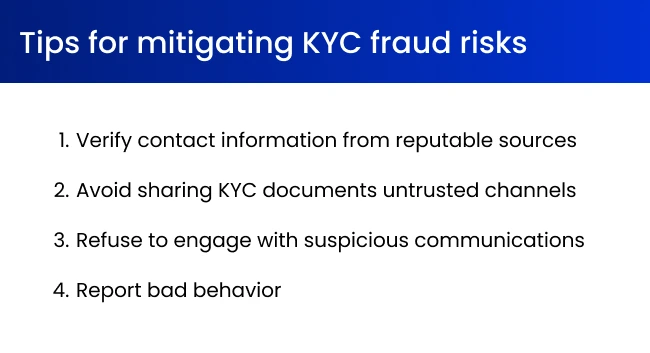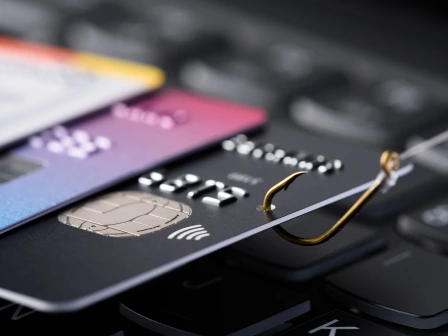KYC fraud: How to detect and prevent it

KYC fraud occurs when criminals use devious methods to circumvent Know Your Customer (KYC) laws. Fraudsters impersonate individuals, forge documents, or go to extreme measures to hide their true identities to open accounts under false pretenses, gain unauthorized access to services, finance terrorist organizations, or launder money through legitimate financial institutions.
Smarty understands the need to protect every institution from KYC fraud. To help you up your game, you need to start building your risk assessment with valid and complete address data. Here are some APIs you can use to accomplish that goal.
| Try real-time address verification in the United States | Try real-time global address verification | See enrichment data surrounding US addresses |
|---|---|---|
KYC fraud falls under the Anti Money Laundering (AML) framework; click here for a refresher on the difference between the two. Otherwise, here's what you can expect to read below:
- Understanding KYC in banking
- Importance of KYC compliance
- Common KYC fraud scams to watch for
- Tips for mitigating KYC fraud risks
- Verify contact information from reputable sources
- Avoid sharing sensitive KYC documents on untrusted channels
- Refuse to engage with suspicious communications
- Report bad behavior
- Implementing automated KYC systems
Understanding KYC in banking
Financial institutions—banks, neobanks, and credit unions—rely on KYC programs to verify user identity, assess fraud risk (money laundering, terrorist financing, etc.), and remain compliant with local and federal laws and regulations. It's a substandard to Anti Money Laundering (AML) compliance.
KYC processes occur when customers or members open an account (personal or business), apply for a loan or line of credit, make any large transaction, and at regular intervals decided by the institution. (You know those super fun emails where they ask you to confirm your address or update your phone number? Yeah, that.)
Importance of KYC compliance

Failing to meet KYC standards carries serious consequences. Non-compliance can result in large fines from regulators, costly legal battles, and the suspension or loss of business licenses. Reputational fallout can be just as painful—losing the trust of users, investors, and regulators can stall growth, drive away customers, and ultimately lead to massive drops in annual recurring revenue (ARR).
Common KYC fraud scams to watch for
Fraud comes in many forms—while most people know not to hop into a stranger's van for the promise of candy or puppies, financial scams still manage to fool us more often than we'd like to admit.
It's not entirely our fault, though; fraudsters are constantly evolving, finding clever ways to exploit complex financial systems and our natural desire for connection. The good news? We're getting sharper at recognizing the red flags.
Here are a few of the signs that KYC scams are afoot, and what to do about them.
Fake messages and phishing attempts
Fake messages and phishing are some of the most common sources of KYC scams. Using email, texts, or even fake web forms, fraudsters will:
- Impersonate legitimate institutions— Financial criminals love to get you to share sensitive information, like identity documents or login credentials, so that they can open new fraudulent accounts, access existing accounts, commit financial fraud, or create synthetic identities to bypass basic KYC checks and balances.
- Exploit autofill and address weaknesses— Using their database of commonly incorrectly validated addresses (false positives), attackers can manipulate the submission or inject fake or altered information to sneak under KYC's radar.
- Use synthetic identities— Like every good lie, it's mostly true. Synthetic identities are created by using real and fake information together (e.g., a valid address + a fake name). Fraudsters build profiles to fool KYC systems, especially ones that don't rigorously cross-check data across different sources.
- Leverage social engineering— Urgency and fear-based attacks are common in financial crimes. Phrases like “Your account will be suspended unless you verify user identity in the next 24 hours,” or “URGENT, please verify your social security number to claim your stimulus check,” can lead an individual to panic and rush to protect their accounts or claim money. The suspicious links can contain viruses to attack the user's system, or worse, mine their data to gain access to other accounts across the web.
Scroll to Tips for mitigating KYC scam risks to see how to avoid these common financial scams, or continue reading below to see more sources of illegal activities to be aware of.
Unverified sources and platforms

Fraudsters love a good loophole, and unverified sources or loosely regulated platforms give them the fast lane to financial crimes that easily skirt KYC programs. Criminals will:
- Target platforms with weak or optional KYC— Some programs and platforms are in the early stages of development or are in less-regulated markets where they may only require basic information, such as a name and email address, to create an account. Without ID verification or address validation, that's a dream come true for a bad actor who wants to open multiple accounts under fake or synthetic identities, launder money across platforms, or test stolen data (like “credential stuffing”) without triggering alerts.
- Exploit peer-to-peer (P2P) and decentralized platforms— While banks and fintechs fall under strict scrutiny, P2P crypto exchanges, NFT marketplaces, unregulated loan services, and messaging apps with payment options don't. Fraudsters have more space to move funds, trade assets, and essentially disappear without ever facing a full identity check by an institution following KYC regulations.
- Use compromised data from data breaches— Data dumps and privacy breaches posted to sketchy sites provide a treasure trove of real user data. Mixing and matching details to create a “Frankenstein” identity (synthetic IDs) might pass a weak KYC check. They then use these personas to leverage shell accounts. Once an account has been compromised or flagged, they move on to the next one. Rinse, repeat.
- Avoid geolocation and address verification— Without address validation or IP geolocation, the user's physical location is never checked. Exploiting this is simple for financial fraudsters as they can spoof their location, set up operations in multiple countries, and operate anonymously.
Jump down to Tips for mitigating KYC scam risks to learn how to steer clear of these common financial traps—or keep reading to uncover more types of fraud you should keep on your radar.
Tips for mitigating KYC fraud risks

What's a fintech to do? Lock down the doors that KYC fraud tends to slip through.
We know it's overwhelming to think about blocking every potential attack from fraud, but putting a few small measures in place can make a world of difference for financial institutions and organizations hoping to escape the clutches of KYC scams.
1. Verify contact information from reputable sources
Reputable sources are ones built with strict guidelines for data protection as well as how they validate their information. They meet high standards for accuracy, authority, security, and have regulatory recognition.
Authoritative address validation
The best way to start? Use authoritative address validation, like Smarty's US Address Verification or International Address Verification tools. As generative AI gets better and more widespread, it's becoming easier to fake a face than an address; a verified address is an essential link in the ID verification chain. Cass-certified address intelligence providers will verify and standardize the data you receive to make sure that alias locations don't slip through your guard as a new, unassigned address.
Analyzing address metadata helps further identify fraud signals; KYC programs can use an address's RDI (residential delivery indicator) and vacancy status to flag suspicious properties, compare device location with address longitude and latitude, and more.
Address validation and metadata analysis give KYC programs a powerful, low-friction way to catch fraud early and confirm a user's identity with greater confidence.
Cross-check phone numbers
Smarty doesn't specialize in this arena (we're masters of the address, not phone numbers), yet we understand the need for this check to be in place for KYC compliance. If you're in Fintech or work for a financial institution, validate entered phone numbers against carrier data to determine if they use a mobile, landline, VoIP, or toll-free number on your form.
You can also check for porting history or disposable phone number databases and employ services that identify whether or not the phone number is active and reachable before sending one-time passwords (OTPs) or 2-factor authentication (2FA) codes to these places.
Verify email addresses beyond syntax
Again, Smarty doesn't have a hand in this type of verification, but it's important nonetheless. Just as an address that looks right can still be wrong, the same goes for email addresses. KYC fintech scams can be avoided by using an email verification API that performs SMTP checks, MX record validation, and domain health scoring.
Basically, you need to know if the domain exists and accepts mail, if it's a free provider or custom-business domain, if the email has been seen in previous breaches or flagged for suspicious activity, and if the inbox is active and reachable.
Confirm consistency and give proper attention to automated flags
Even after verifying these points, it's important to recognize that they all work together in a massive machine under KYC. Cross-referencing addresses, names, phone numbers, email addresses, etc., across identity graphs and third-party providers can be a valuable asset to stopping financial fraud in its tracks. Checking for a historical trail associated with a person via these identifiers will help you know whether or not you should dig deeper into a risk profile.
2. Avoid sharing sensitive KYC documents on untrusted channels
When we say “avoid sharing sensitive KYC documents on untrusted sites,” what we really mean is that documents such as passport scans, driver's licenses, utility bills, bank statements, social security numbers (SSN), or national IDs should never be shared through unsecure, unverified, or informal communication platforms. Anything with personally identifiable information (PII) needs to be treated like Nic Cage is trying to steal it.
Examples of untrusted channels might be:
- Over public Wi-Fi (without encryption)
- Social media platforms (DMs, posts, etc. via Facebook, Instagram, X, etc.)
- Messaging apps lacking end-to-end encryption (or really any messaging apps in general, as you typically can't verify who's on the other side)
- Email if the recipient's domain or system isn't secure
- Uploading to unknown websites or cloud drives without HTTPS or proper credentials
Secure and verified portals are the way to go if you need to send sensitive identity documents anywhere. Use services that encrypt and store KYC data securely, and be sure to confirm the legitimacy of the requester before sending information out.
3. Refuse to engage with suspicious communications
If it seems to be too good to be true, it probably is. Communications that are suspicious in nature could be links where the text isn't truly representing where the link will take you, messages with pressure tactics regarding suspended accounts or “right now” type of language, unknown or unofficial senders, misspelled domains, people claiming to be KYC agents or support chats that appear without being initiated by you.
4. Report bad behavior
Not only should you refuse to engage with shifty communications, but you can also do your part to report scams in the appropriate channels, like reaching out to the specific company the fraudster is trying to impersonate. Many websites will have a button to report fraud, contact support, or speak with the security center.
You can also report suspicious email communications through phishin@report.cyber.gov (for the US) or reportphishing@apwg.org (for global occurrences), as well as block them and report them as spam in your email provider's settings.
If you are being targeted through SMS or phone, you can report the number to your mobile carrier, forward suspicious texts to 7728 (which spells SPAM) if you live in the US, and/or report them to the FCC at https://consumercomplaints.fcc.gov.
In summation:
- Report to the company involved first
- Use official government reporting tools for financial crimes
- Never respond to or engage with suspicious messages
- Never respond to or engage with unofficial requests to upload KYC documents to unverified sites.
Implementing automated KYC systems
Now that you understand what to do if you feel you have been compromised, let's discuss how financial institutions and banks can take a more proactive approach to fraud detection. There are ways that bank officials and financial institutions can become aware of the potential risks before they occur. Implementing automated KYC systems into your existing platforms can simplify KYC fintech compliance and help you avoid the hefty fines associated with noncompliance.
Benefits of advanced customer identity verification

Advanced verification of the identity of customers has several perks.
First, you can significantly reduce KYC fraud and financial crime, thereby improving regulatory compliance and decreasing litigious fines.
Second, onboarding and approvals processes are streamlined.
Account takeovers are reduced through behavioral analytics, biometric re-authentication, and device fingerprinting.
Finally, the extra checks and balances implemented to keep a user's data secure also enhance user trust and boost brand reputation.
The benefits are there, and to keep them there, continuous monitoring and alerts are necessary. Advanced identity verification is not a one-and-done process.
Continuous monitoring and alerts
Even if a customer passes the initial checks, their behavior might shift over time. Ongoing monitoring can catch things like sudden address changes, phone number changes, or email changes (a sign of account takeover), keeping your customer profiles and risk up to date and fresh.
Additionally, continuous monitoring supports dynamic risk scoring, triggers real-time alerts for faster action, and enables financial institutions to manage regulatory compliance and reporting, which require detailed documentation.
Enhancing your fraud detection mechanisms, boosting employee training and awareness, and performing regular security audits are all great ways to avoid KYC fraud, and they all begin with address verification.